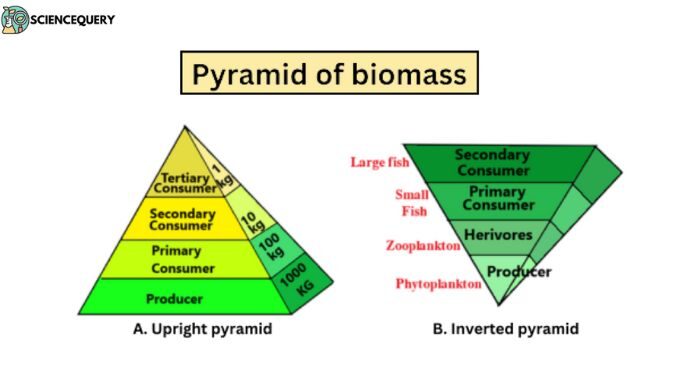
Know in one minute about the Pyramid of Biomass
|
Introduction
There are three types of ecological pyramids. These are the pyramid of numbers, the pyramid of biomass, and energy. The trophic structure of an ecosystem is called an ecological pyramid. G. Elton first described this pyramid (2).
- When energy is transferred from one trophic level to another in an ecosystem, some of the energy is returned to the environment as thermal energy, reducing the total energy in the net trophic level. Because of this, less energy is transferred to the next food level.
- As a result, the number of organisms decreases. Because more organisms are not able to provide the previous trophic level with energy.
- For this region, the food pyramid is formed by successively arranging the number, biomass, and energy transfer of organisms from the lower trophic level to the higher trophic level.
- So the ecological pyramid plays an important role in an ecosystem (1).
Definition
The dry weight of organisms in a particular trophic level of an ecosystem is called biomass. The pyramid obtained by arranging these organisms at each level of the food chain is called the pyramid of biomass (3).
Structure
The lowest tropical level is having the highest amount of biomass like the pyramid of numbers and energy. Then there is a gradual decline from producers to the primary consumer followed by secondary consumers and then tertiary consumers.
It has been observed that in various ecological pyramids, 15% to 20% of the biomass of one food level or trophic level is transported to the next trophic level. Hence biomass decreases progressively from the initial trophic level of the biomass pyramid towards the higher trophic levels and the highest trophic level has the least amount of biomass (2) & (5).
Description
A pyramid-shaped diagram that arranges the organisms at each trophic level sequentially in a food chain is called a pyramid of biomass. Biomass is an ecological term. It refers to the total mass of all living or organic elements in an ecosystem at a given time. There are two types of biomass, species biomass, and community biomass. The cone-shaped figure that sums up the total mass of species in an ecosystem is the biomass pyramid (4).
Pyramid of biomass: Types
There are two types namely upright and inverted pyramids of biomass.
Upright pyramid of biomass
- It is formed when the biomass of producers is higher than consumers.
- The base of this type of pyramid is wide.
- In this case, the biomass of primary consumers, the next trophic level, is lower than that of producers.
- And the biomass of secondary consumers, the next higher trophic level, is lower than that of primary consumers in the upright structure (2) & (3).
The inverted pyramid of biomass
- The inverted pyramid can only be observed in aquatic ecosystems.
- The base of this type of pyramid is narrow.
- Here consumer biomass always exceeds producer biomass (2) & (3).
Characteristics
- This pyramid is formed by arranging the biomass of organisms in the ecosystem.
- Like the pyramid of numbers, this can be both upright and inverted.
- It is very essential in the food chain.
- This indicates the total dry weight of each trophic level in a particular food chain in an ecosystem.
- Inverted biomass pyramids can be observed in pond ecosystems.
- The structural unit is kilogram/ square meter/year.
- It is based on the laws of thermodynamics.
- This can be used to calculate the amount of organic matter at different trophic levels.
- Here the producer level has the highest biomass and the highest level has the lowest biomass.
- In this pyramid, biomass decreases progressively from the bottom of this type of ecological pyramid to the higher levels.
- in this, the producers are at the bottom and carnivores are at the top, except for the aquatic ecosystem. So the base is wide and the top is progressively narrower (1) & (6).
Examples
In a grassland ecosystem, the biomass of productive grass species is highest. Then the biomass gradually decreases from the primary consumer (deer) to the secondary consumer (jackal) and from the secondary consumer to the tertiary consumer (tiger). Biomass is lowest at the highest nutrient levels (6).
Q&A
1. What does a pyramid of biomass represent?
It represents the total living biomass present at different trophic levels in an ecosystem. It shows the dry weight of organisms at each layer in a food chain.
2. How much biomass is on earth
The total live biomass on earth is about 550- 560 billion tons C. And the total annual primary production of biomass is about 100 billion tonnes C/ year.
3. Why pyramid of biomass in aquatic ecosystems is inverted?
The biomass of fish is higher than that of phytoplankton. So it in aquatic ecosystems is always inverted.
4. What is a pyramid of biomass in biology?
In biology, a food pyramid constructed based on the dry weight of organisms at different levels of the food cycle in an ecosystem over a period of time.
5. How to draw pyramid of biomass?
It represents the mass of organisms at each trophic level. So can be drawn by adding the biomass of organisms in an ecosystem.
6. What pyramid of biomass?
The number or quantity of all living organisms consisting of all plants and animals at a place or in an ecosystem over a period of time is called biomass. By arranging this biomass of organisms in succession, the cone-shaped figure is obtained.
7. What is pyramid of biomass in ecology?
In ecology, it is formed by arranging the dry weight or biomass of different organisms according to the trophic level in an ecosystem.
Written By: Manisha Bharati
